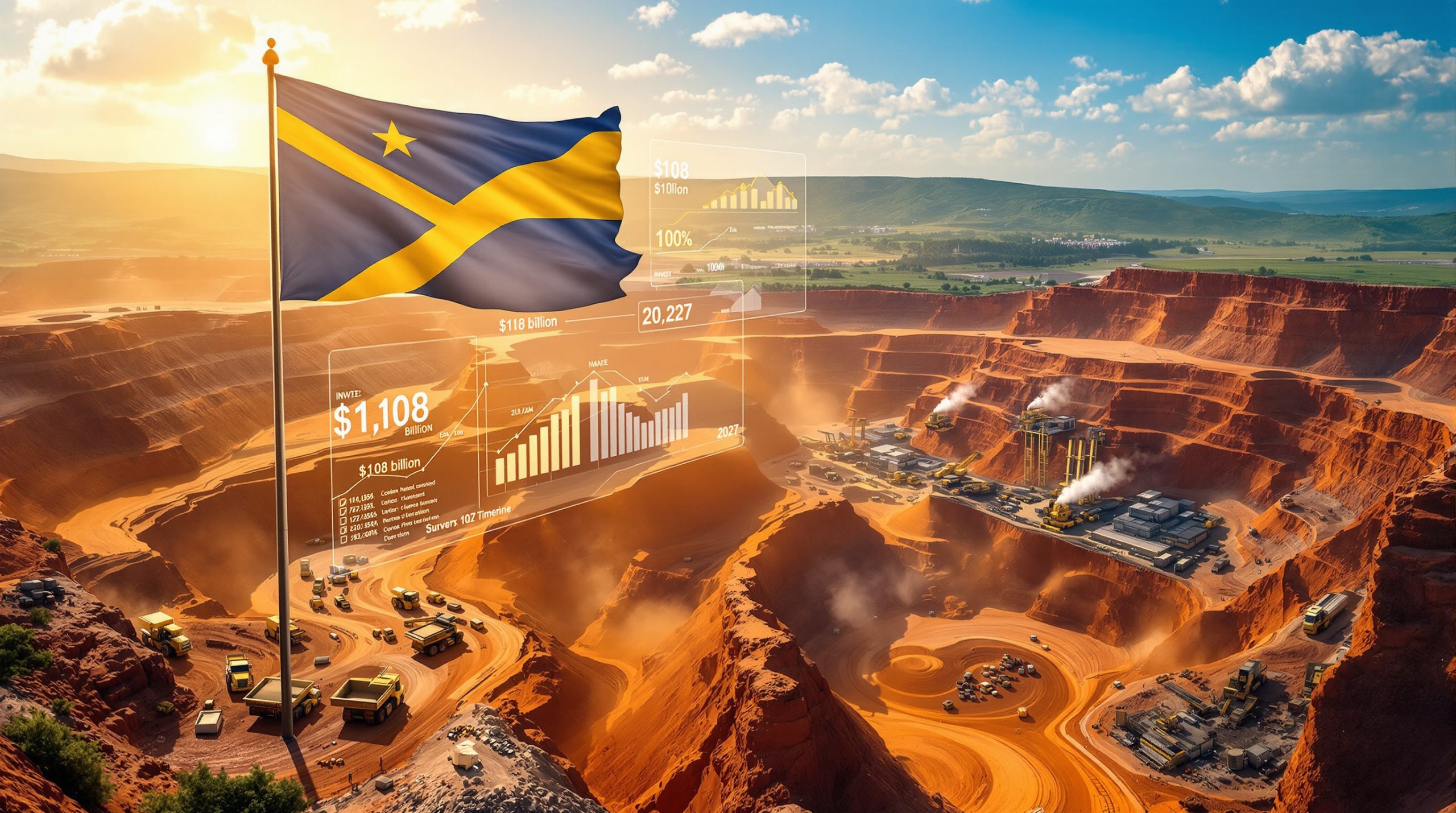Australia's Critical Minerals Strategy: Navigating the Crossroads
Australia stands at a critical juncture in the global race for critical minerals dominance. Despite holding the world's third-largest reserves of rare earth elements, Australia currently accounts for only 3% of global production—representing an enormous untapped potential that could reshape the nation's economic future and global standing in strategic resources.
The gap between Australia's resource potential and actual market share highlights both a challenge and opportunity. With critical mineral shortages being essential components for renewable energy technologies, specialized medical equipment, and advanced defense applications, the stakes couldn't be higher for getting the strategy right.
What Is Australia's Critical Minerals Potential?
Australia's Position in the Global Critical Minerals Market
Australia's position as the holder of the world's third-largest rare earth reserves stands in stark contrast to its modest 3% share of global production. This disparity represents one of the most significant resource opportunities in the country's mining history, potentially rivaling the iron ore boom of previous decades.
"Our mineral wealth is extraordinary, but we've barely scratched the surface of our critical minerals potential," notes Rebecca Tomkinson, CEO of the Chamber of Minerals and Energy Western Australia (CMEWA). "The global energy transition is creating unprecedented demand, yet we're still playing a minor role in the supply chain."
These minerals aren't just economically valuable—they're strategically essential. Critical minerals form the backbone of technologies driving the clean energy decarbonisation, with rare earth elements used in approximately 90% of wind turbine magnets and 80% of electric vehicle motors worldwide.
Key Critical Minerals in Australia's Portfolio
Australia's critical minerals profile is diverse and strategically significant. The country holds substantial deposits of neodymium and praseodymium—rare earth elements crucial for permanent magnets used in wind turbines and electric vehicles. Australian dysprosium, another rare earth element, is essential for defense applications including radar systems and guidance components in fighter jets and submarines.
Beyond rare earths, Australia has significant reserves of cobalt, lithium, and nickel—all essential for battery technologies. The country also holds deposits of gallium and indium, which are increasingly important for medical imaging equipment and specialized surgical devices.
What makes these resources particularly valuable is not just their abundance but their geopolitical significance. As Western nations seek to reduce dependency on Chinese supply chains, Australia's reserves represent a potential democratic alternative in an increasingly contested strategic landscape.
What Is the Government's Proposed Critical Minerals Strategy?
The Critical Minerals Strategic Reserve Proposal
The Labor Government has proposed a two-pronged approach to developing Australia's critical minerals sector if re-elected. First, national offtake agreements would be established to acquire agreed volumes from commercial mining projects, providing predictable revenue streams for producers. Second, selective stockpiling would target minerals deemed necessary for national security purposes.
This voluntary structure allows producers to secure stable revenue without mandatory participation, potentially enhancing project attractiveness to investors who often cite market uncertainty as a major hurdle. The proposal aims to address the "chicken and egg" problem that has plagued the sector—investors hesitate without guaranteed buyers, while buyers are reluctant without established supply.
"The strategic reserve concept aims to provide the market certainty needed to bring projects online," explains an industry analyst familiar with the proposal. "It's designed to be a catalyst rather than a permanent market intervention."
The government emphasizes that this approach would complement rather than replace private investment, with the ultimate goal of establishing Australia as a trusted supplier in global market insights and critical minerals supply chains.
Industry Response to the Strategic Reserve
The industry response to the strategic reserve proposal has been mixed, revealing divergent views about the appropriate role of government in mineral resource development. The Minerals Council of Australia (MCA) has questioned the fundamental merits of the strategic reserve approach, suggesting it may not address core competitiveness issues.
In contrast, the Chamber of Minerals and Energy Western Australia has offered conditional support while emphasizing specific concerns. CMEWA CEO Rebecca Tomkinson has been particularly vocal about pricing mechanisms: "It is critical that offtake agreements offer a fair price reflective of Australia's high ESG standards," she stated, highlighting the importance of recognizing Australia's superior environmental and social practices compared to competitors.
Both industry bodies emphasize the need for extensive consultation before finalizing implementation mechanisms. There appears to be consensus that while government support is welcome, the details matter tremendously—particularly around pricing, contract terms, and selection criteria for participating projects.
What Are the Key Challenges Facing Australia's Critical Minerals Sector?
Regulatory and Economic Barriers
Australia's critical minerals sector faces substantial competitive disadvantages despite its resource wealth. Energy prices stand as a major obstacle, with Australian mining operations facing costs 30-40% higher than competitors in Canada and Chile, significantly affecting project economics and investment decisions.
The current industrial relations framework has been described as "draconian" by MCA CEO Tania Constable, who argues these regulations create inflexibility that disadvantages Australian operations compared to international competitors. "When you're competing globally, every cost counts," she notes. "Our regulatory burden has become a competitive millstone."
Environmental approval processes represent another significant barrier, with typical timelines stretching 2-3 years longer than comparable jurisdictions like the United States. This regulatory delay translates directly into higher capital costs and delayed returns for investors, making Australian projects less attractive in global capital markets.
Investment and Market Development Obstacles
Securing capital for critical minerals projects presents a particular challenge due to the technical complexity, processing requirements, and market uncertainties. Unlike established commodities with transparent pricing and liquid markets, critical minerals often face opaque pricing mechanisms and concentrated buyer markets.
The gap between Australia's resource potential and production capabilities reflects this investment challenge. Projects require substantial upfront capital but face uncertain demand projections and potential price volatility, creating a risk profile that many investors find prohibitive without additional certainty.
International competition compounds these challenges. Countries including Canada, the United States, and various African nations are actively developing their own critical minerals strategies, often with substantial government support, creating a complex competitive landscape for Australian projects seeking investment.
How Can Australia Regain Its Competitive Edge?
MCA's Proposed Alternative Approach
The Minerals Council of Australia advocates for fundamental economic reforms rather than strategic reserves. Their approach centers on addressing the structural disadvantages facing Australian mining operations through targeted policy changes.
"We must focus on the fundamentals that will give Australia back the edge over other mining nations," argues MCA CEO Tania Constable. The MCA's reform agenda includes reducing energy prices through increased domestic gas supply and renewable integration, reforming industrial relations laws to enhance operational flexibility, and streamlining environmental approval processes while maintaining high standards.
The MCA suggests these reforms could potentially reduce project development timelines by up to 50% and significantly improve operational cost structures, making Australian projects more attractive without direct government market intervention.
This approach leverages Australia's existing mining industry strengths—technical expertise, established infrastructure, and governance stability—while addressing specific competitive disadvantages that have emerged in recent years.
Balancing Government Intervention and Market Forces
The debate over Australia's critical minerals strategy ultimately centers on finding the right balance between government support and market-driven development. While there's broad agreement that critical minerals represent a strategic opportunity, opinions diverge on implementation.
The key question concerns the appropriate level of government involvement. Should government directly enter the market through offtake agreements and stockpiling, or should it focus on creating enabling conditions through regulatory reform and targeted incentives?
Any offtake agreements must offer fair market pricing to avoid distorting investment signals or creating dependencies. Industry advocates emphasize that Australia's high ESG standards represent a competitive advantage that should be reflected in pricing models, particularly as export restrictions impact global markets and buyers increasingly prioritize responsible sourcing.
Creating mechanisms that genuinely support bringing projects to market remains the shared goal across differing approaches. Whether through direct market participation or enabling reforms, the focus must remain on addressing the specific barriers that have kept Australia's critical minerals potential largely untapped.
What Do Industry Experts Say About the Path Forward?
Expert Perspectives on Critical Minerals Development
Industry leaders offer contrasting visions for Australia's critical minerals future while agreeing on the fundamental importance of the sector. MCA CEO Tania Constable emphasizes structural reform: "We must focus on the fundamentals that will give Australia back the edge over other mining nations. Lower energy prices, more efficient approvals, and competitive industrial relations policies are essential."
CMEWA CEO Rebecca Tomkinson offers a different emphasis: "It is critical offtake agreements offer a fair price reflective of Australia's high ESG standards. Any government procurement strategy must recognize Australia's superior environmental and social practices."
There is industry consensus on the need for extensive consultation before finalizing policy approaches. Experts emphasize that poorly designed interventions could undermine rather than support sector development, highlighting the delicate balance required.
Mining economists note that Australia has significant advantages in technical expertise and infrastructure that could be leveraged through appropriate policy settings. "Australia's mining engineering capabilities are world-class," explains one industry analyst. "The right frameworks could unlock tremendous value-adding potential."
Comparative Approaches from Other Mining Nations
Australia's critical minerals strategy must be considered in the context of global competition. Canada has implemented a Critical Minerals Strategy with substantial tax incentives and streamlined permitting for priority projects, while the United States has established the Defense Production Act Title III program to directly fund critical minerals development.
The European Union has created the European Raw Materials Alliance to secure supply chains, demonstrating a collaborative approach between government and industry. These international examples offer valuable lessons for Australia's critical minerals crossroads.
Competitive positioning against major producers, particularly China, which dominates rare earth processing globally, requires careful strategic planning. Australia's high-grade deposits and stable political environment offer advantages, but cost structures and processing capabilities require attention.
Potential international partnerships present another avenue for development. Japan and South Korea have expressed interest in securing Australian critical minerals supplies, potentially offering technology transfer and investment opportunities that could accelerate sector development.
FAQ: Australia's Critical Minerals Strategy
What are critical minerals and why are they important?
Critical minerals are elements with essential applications in modern technologies that face supply risks due to geological scarcity, geopolitical issues, or processing limitations. In the Australian context, these include rare earth elements, lithium, cobalt, tungsten, and other specialized minerals.
These materials are fundamental to renewable energy technologies, with rare earth magnets essential for wind turbines and electric vehicles. Defense applications are equally significant, with specialized alloys required for aerospace components and advanced weapons systems.
The strategic importance extends beyond economic value to national security considerations. As military hardware increasingly depends on these materials, secure supply chains become vital for defense capability maintenance.
Their role in global technology supply chains makes them important beyond their raw material value. Countries that control critical minerals supply gain significant geopolitical leverage in an increasingly technology-dependent world.
How does Australia's critical minerals strategy compare internationally?
Australia's approach differs significantly from North American strategies, which feature more direct government investment and streamlined regulatory pathways for critical projects. The Canadian Critical Minerals Strategy includes substantial tax incentives for exploration and processing that currently exceed Australia's offerings.
European approaches emphasize recycling and circularity alongside new production, an area where Australia could potentially enhance its strategy. The EU's focus on processing technology development represents another area where Australia currently lags.
Australia maintains competitive advantages in resource quality and political stability but faces higher operating costs and longer development timelines than many competitors. These factors affect international competitiveness despite superior ESG credentials.
Australia's position within global critical minerals supply chains remains underdeveloped relative to resource potential, particularly in processing and value-adding activities where China maintains dominance despite Australia's superior raw material position.
What are the environmental considerations for critical minerals development?
Environmental, Social, and Governance (ESG) standards represent both a challenge and opportunity for Australia's critical minerals sector. Australia's mining operations typically adhere to ISO 14001 certification and world-leading rehabilitation practices, creating a potential premium product for environmentally conscious buyers.
Balancing extraction with environmental protection requires sophisticated approaches to water management and energy use. Critical minerals processing is often energy-intensive, making renewable energy integration important for both environmental and cost considerations.
Sustainability practices in processing represent a particular challenge, as some extraction methods involve significant chemical use. Australian research into more environmentally friendly processing technologies could create competitive advantages while minimizing environmental impact.
Rehabilitation and closure planning are increasingly important considerations for project approval. Best practices include progressive rehabilitation and post-mining land use planning integrated from project inception rather than as afterthoughts.
What role will critical minerals play in Australia's economic future?
Critical minerals development presents significant economic diversification opportunities beyond traditional mining exports. The sector could generate substantial employment in regional areas, particularly if processing facilities are co-located with extraction operations.
Downstream processing represents the most significant value-adding opportunity. While Australia currently exports most critical minerals as concentrates, developing processing capability could multiply economic returns while strengthening supply chain security.
Integration with Australia's broader resources strategy requires careful planning to leverage existing infrastructure and expertise. The critical minerals sector could benefit from knowledge transfer from established mining operations while developing specialized capabilities.
The economic potential extends beyond direct mining value to technology development and manufacturing opportunities. Australia's technical mining expertise could be leveraged to develop proprietary extraction and processing technologies with global export potential, creating a knowledge economy alongside resource extraction.
The recent Iluka rare earth investment demonstrates the government's commitment to developing domestic processing capabilities, representing a significant step toward capturing more value from Australia's mineral resources.
Ready to Spot the Next Major Australian Mining Discovery?
Stay ahead of the market with Discovery Alert's proprietary Discovery IQ model, delivering instant notifications when significant ASX mineral discoveries are announced—precisely the kind that could reshape Australia's critical minerals future. Explore how historic discoveries have generated substantial returns by visiting the dedicated discoveries page and gain your market-leading advantage today.




